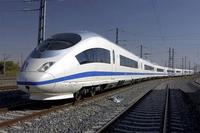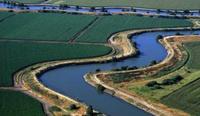-
Waste ash from coal could save billions in repairing U.S. bridges and roads
The more than 450 coal-burning electric power plants in the United States produce about 130 million tons of “flyash” each year; before air pollution laws, those fine particles of soot and dust flew up smokestacks and into the air; power plants now collect the ash; researchers say that coating concrete destined to rebuild America’s crumbling bridges and roadways with some of the millions of tons of that left-over ash could extend the life of those structures by decades, saving billions of dollars of taxpayer money
-
-
California schools seismically unsafe, lack funding for retrofits
Hundreds of thousands of students across California are at risk, as school districts have not retrofitted aging concrete buildings that are susceptible to collapse; the state has identified dozens of structures at schools that are at risk of collapsing in a strong earthquake, but most are still in use and have no plans for repairs; engineers are particularly concerned about old concrete school buildings that were erected before 1976; these structures are constructed with “non-ductile” concrete, a type of material that did not hold up well in the recent earthquake in New Zealand; cash-strapped school districts are hesitant to begin long and expensive retrofitting projects even with state help
-
-
Senate proposes new $10 billion "infrastructure bank"
Several U.S. Senators are pushing for the creation of a $10 billion “infrastructure bank” to spur investment in new infrastructure and to repair America’s rapidly aging roads, power grids, and bridges; the bill could attract as much as $640 billion in private investment over the next ten years; the Obama administration has proposed a similar plan; the bank would be self-sustaining as it is not allowed to finance more than 50 percent of a project’s costs; this bill faces an uncertain future given the current Congressional budget climate
-
-
Oregon declares state of emergency to repair damaged ports
The 11 March tsunami born of Japan’s 8.9 magnitude quake battered U.S. coasts and ports from Hawaii and the Pacific Northwest to southern California; the governor’s office in Hawaii expects damages to run about $10 million with estimates heading toward $50 million in California; one county in Oregon is reporting $25 million worth of destruction in one of three damaged ports
-
-
Shock absorbers making buildings earthquake-proof
An upstate New York manufacturer has developed dampers, or shock absorbers, which increase the earthquake resistance of a building by threefold; the patented dampers are based on technology first developed by the military to protect U.S. missile silos against Russian attacks during the cold war
-
-
New Orleans debates hurricane protection plans

The Army Corps of Engineers is currently deciding how best to implement its $2.9 billion Mississippi River-Gulf Outlet (MR-GO) restoration plan in New Orleans; the plan is part of several projects designed to protect the Louisiana coast line from hurricane storm surges; residents are clashing over the plan and the public hearing period for the plan has been extended; state legislators are currently debating with the corps, as the $2.9 billion project funds do not include the costs for land acquisition, design, and operation and maintenance; the project is expected to take ten years to complete and construction could begin as early as 2012
-
-
Building smarter infrastructure out of the rubble
As Australia and New Zealand look to rebuild following the natural disasters in Christchurch and Queensland, experts have found a silver lining: the opportunity to rebuild with smarter infrastructure; architects, risk managers, and other experts say that cities devastated by natural disasters should amend building codes and implement smarter technology in buildings as they are resurrected from the rubble
-
-
Britain struggles to contain rampant copper thefts
Britain is struggling to stop thieves that are stealing large quantities of copper from rail yards; the cost of these thefts to the British government has doubled to roughly $1.25 billion a year; the price of copper has hit all-time highs at just over $10,000 per ton, which has driven organized gangs to conduct dangerous raids on rail way stations; the gangs climb on to the tracks and use power tools to cut down all the copper cables they can including train signaling, electricity, and data cables; thefts are expected to increase as the demand from China is projected to push copper prices even higher
-
-
Building codes increasingly unable to withstand extreme weather
Basic infrastructure around the world has had increasing difficulty in withstanding more extreme weather patterns; with record snow falls in the Northeastern United States, hundreds of roofs have collapsed under the weight of snow and in 2008 heavy snows in China caused 223,000 homes to collapse resulting in $1 billion in insured damages; engineers and insurers worry that current building designs may not be able to withstand more extreme weather patterns; engineers have built more robust safety mechanisms into their designs, but municipal building codes that determine the minimum standard have lagged behind; insurance companies have changed their policies to offer lower premiums to homes that are better built and have refused to insure homes in high-risk areas
-
-
Maryland wants Florida's high speed rail funds

As Republican governors in Florida, Wisconsin, and Ohio reject federal funding for high speed rail projects, states like Maryland are clamoring to receive those funds; Maryland Senators Benjamin L. Cardin and Barbara A. Mikulski sent a letter to Transportation Secretary Ray LaHood requesting that $2.4 billion dollars in high speed rail funding originally designated for Florida be redirected to projects in the Northeast Corridor; each year 250 million rail passengers use the corridor and passenger use is projected to increase by 60 percent by 2030; the White House plans to spend $53 billion on high speed rail projects over the next six years and $8 billion in the coming fiscal year alone
-
-
China plans to build alternative to Panama Canal
China recently struck a deal with Colombia to build a railway system that would connect the Atlantic to the Pacific oceans; China hopes this link will create a viable alternative to the Panama Canal; the railway would help ease China’s growing demand for raw materials, particularly coal, and act as an additional outlet for Chinese exports; Colombia is the fifth largest coal producer in the world, but most of its coal is exported through its ports on the Atlantic side; trade between China and Colombia has skyrocketed from $10 million in 1980 to $5 billion in 2010
-
-
Expert urges broad reforms in managing California's water

Most threatening to California’s water situation is the vulnerability of the hub of the state’s fresh water system, the Sacramento-San Joaquin delta, which drains water from the northern Sierra mountains; over the past century, farmers have built a network of more than 1,700 kilometers of levees to protect farmland in the delta from floodwaters; those levees are weak and vulnerable to earthquakes, seasonal floods, and rising waters expected as a result of climate change; the failure of even a fraction of the levees would draw massive amounts of saltwater in from San Francisco Bay, forcing the state to shut off the pumps, cutting off water supplies for many months, and costing the state’s economy billions of dollars
-
-
Danger building up behind aging, vulnerable dams
Of the U.S. 85,000 dams, more than 4,400 are considered susceptible to failure; a 2009 report put the cost of fixing the most critical dams — where failure could cause loss of life — at $16 billion over twelve years, with the total cost of rehabilitating all dams at $51 billion; those figures do not include dams among the approximately 3,000 that are owned by the federal government; the Army Corps of Engineers, for example, says that more than 300 of the roughly 700 dams it is responsible for need safety-related repairs, and estimates the total fix-up bill at about $20 billion
-
-
Haiti's quake damage yields better building codes

In the aftermath of the 7.0 magnitude earthquake that shook Haiti last year and killed more than 300,000 people, University of Arizona researchers descended upon the country’s capital to study buildings that survived the quake; researchers documented damaged buildings to develop a sophisticated three dimensional model; they are working to develop stricter building codes to ensure that buildings can withstand earthquakes in the future; their focus is on designing low-cost easy to implement localized solutions; buildings that were not built to withstand earthquakes were the primary cause of death in the disaster
-
-
Boston has new pot-hole weapons
In a typical year, the city of Boston fills about 19,000 potholes; the city now has two new pot-hole weapons in its arsenal: a $151,300 Pro-Patch Pothole Patcher truck, and a new iPhone and Android app, called Street Bump, which would automatically report potholes to the city by sensing when a car has hit a bump (the app has not been released yet, but test-drives are already being conducted)
-
- All
- Regional
- Water
- Biometrics
- Borders/Immig
- Business
- Cybersecurity
- Detection
- Disasters
- Government
- Infrastructure
- International
- Public health
- Public Safety
- Communication interoperabillity
- Emergency services
- Emergency medical services
- Fire
- First response
- IEDs
- Law Enforcement
- Law Enforcement Technology
- Military technology
- Nonlethal weapons
- Nuclear weapons
- Personal protection equipment
- Police
- Notification /alert systems
- Situational awareness
- Weapons systems
- Sci-Tech
- Sector Reports
- Surveillance
- Transportation
Advertising & Marketing: advertise@newswirepubs.com
Editorial: editor@newswirepubs.com
General: info@newswirepubs.com
2010-2011 © News Wire Publications, LLC News Wire Publications, LLC
220 Old Country Road | Suite 200 | Mineola | New York | 11501
Permissions and Policies
Editorial: editor@newswirepubs.com
General: info@newswirepubs.com
2010-2011 © News Wire Publications, LLC News Wire Publications, LLC
220 Old Country Road | Suite 200 | Mineola | New York | 11501
Permissions and Policies
